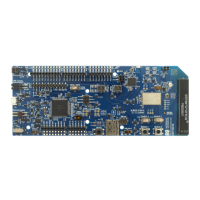Hardware description
nRF52 switch control
The GPIOs on nRF52840 that are used to control the analog switches selecting between default and
optional routing.
Source nRF9160
The GPIOs on nRF9160 that can be configured to have an alternative routing.
Destination "Default"
The default destination for the "Source nRF9160" if the "nRF52 switch control" pins are set as output
and pin driver is low.
Destination "Optional"
The optional destination for the "Source nRF9160" if the "nRF52 switch control" pins are set as
output and pin driver is high.
The setup described as "Destination Default" in the table above is active if all the GPIOs on nRF52840
listed as "nRF52 switch control" are set as output and driven low. There is a pull-down resistor on the
switch control lines, and therefore, "Destination Default" can also be received if the control lines from the
nRF52840 are not driven. If the optional routing is desired, the "nRF52840 switch control" pins have to be
set as outputs and driven high.
The nRF52840 is preprogrammed with firmware that provides the default destination setting. Configurable
code examples for the nRF52840 allowing to change the board routing can be found in the nRF Connect
SDK. After the changes are done, the new program must be compiled and programmed to the nRF52840.
Note: To program and debug the nRF52840, nRF52 needs to be selected on the PROG/DEBUG
switch (SW5).
Since this firmware in the nRF52840 decides the nRF9160 DK behavior, it is vital that it is always present
in the nRF52840. If it is accidentally erased or firmware affecting the use of the key nRF52840 GPIOs
is programmed in, nRF9160 DK functionality is not guaranteed. In such cases, nRF52840 needs to be
preprogrammed with the default board control firmware from the nRF Connect SDK.
4.7.2 Bluetooth/IEEE 802.15.4 network processor
A second function of the onboard nRF52840 is to act as a Bluetooth or IEEE 802.15.4 network processor.
This makes it possible to develop products that utilize both LTE and other RF protocols supported by
Nordic on the nRF9160 DK.
Since most of the GPIOs of the nRF52840 are used for board control (see the schematic below), it is not
intended to be a full programming and development target on the nRF9160 DK.
However, if combined with board control firmware, it can run code that requires limited access to GPIO,
such as wireless controllers or network processor implementations of Bluetooth and IEEE 802.15.4
protocols from Nordic Semiconductor.
This enables the nRF9160 DK to implement a cellular to Bluetooth (and/or IEEE 802.15.4) bridge or
gateway. To enable this, nRF52840 has a 2.4 GHz antenna fitted along with nine GPIOs that can be
connected to nRF9160 through the board control routing. For details, see Table 4: Board control routing on
page 21.
Firmware examples for such bridge or gateway implementations can be found in nRF9160: LTE Sensor
Gateway.
4418_1216 v0.9.1
22

